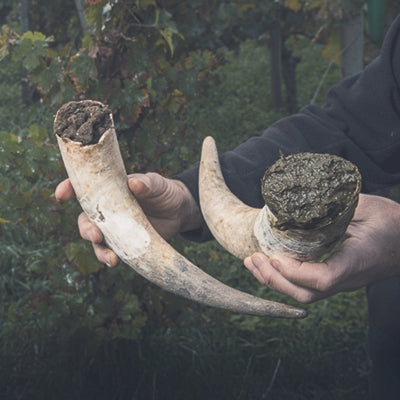
Biodynamics part II: the practical steps
In this second part of our biodynamics series, Westgarth Wines specialist Maurizio Broggi discusses the practical steps taken in biodynamic viticulture; from composting to celestial influences.
Biodynamic preparations & compost
Two fundamental field preparations in biodynamics are preparation 500 (horn manure) and preparation 501 (horn silica).
Preparation 500
Preparation 500 is created by placing cow manure in cow horns and burying them for six months during the autumn and winter. This transforms them into nutrient-dense organic matter to be applied to the soil to stimulate microbial activity, improve soil structure and fertility, and enhance organic matter. Additionally, this also promotes root growth.
Preparation 501
Preparation 501 is made by placing ground quartz in cow horns and burying them for six months during the spring and summer. Mixed with water it is sprayed on leaves to amplify the effects of sunlight and stimulate vine growth. Another similar field preparation to 501 used in biodynamic viticulture is preparation 508, derived from common horsetail, which is a silica-rich weed used to deter fungal diseases.
Compost
As in organic viticulture, compost is a fundamental component of biodynamic farming. However, in biodynamics, compost plays an even more pivotal role. Serving not only as a source of humus, the dark organic material formed in soil by the decay of plant and animal matter, compost also provides energetic forces to vitalize the vineyard.
The compost is created using animal manure, which must be activated by adding six specific preparations: yarrow (502), chamomile (503), nettles (504), oak bark (505), dandelion (506), and valerian (507). These preparations promote the decomposition of the compost and are believed to increase humus levels.
Animal influence
Some of these preparations are pre-fermented using animal organs as sheaths, such as red deer bladders, cow intestines, or animal skulls. This practice is said to enhance their properties and amplify their beneficial effects.
Biodynamic winegrowers recognize that manure from different animal species possesses unique qualities that may be more suitable for specific purposes. Nicolas Joly, a renowned biodynamic guru and owner of Coulée de Serrant in Savennières, suggests, for example, that pig manure is particularly beneficial for root growth.
The celestial influences of biodynamic calendars
Celestial influences play a crucial role in the timing of biodynamic practices, such as the making and application of preparations, planting, and pruning among several others. The fundamental belief is that lunar and celestial cycles exert energetic forces that influence vine growth. The biodynamic calendar, therefore, is an essential component of biodynamic farming, as practitioners align their grape-growing practices with the cycles of the planets, moon, and stars.
The biodynamic calendar
A prominent biodynamic calendar was developed in the 1960s by German agriculturalist Maria Thun. Based on planetary alignments, vines are believed to be influenced by both earthly and cosmic forces. In biodynamics, plants are composed of four elements: roots, leaves and shoots, flowers, and fruit. These components are thought to be directly connected to earth, water, air, and solar radiation, respectively.
Each of these elements is believed to be favorable during specific phases of the moon's cycle around Earth, as the moon passes in front of the twelve constellations of the astrological zodiac.
Celestial influence
Key operations such as planting, pruning, plowing, harvesting, and even cellar activities like racking or bottling are timed according to a schedule that aligns with the forces exerted by earthly and celestial rhythms, particularly the moon.
For instance, during the "ascending" moon, sap is believed to rise, making it an ideal time for taking cuttings for grafting while pruning should be avoided. Conversely, the "descending" moon is considered favorable for roots, making it an appropriate time for pruning or planting vines.
Stay tuned for part III of our biodynamic series, which explores the costs, hindrances and controversies surrounding biodynamic viticulture.
Want to read more? Take a look at some of our other blogs:



